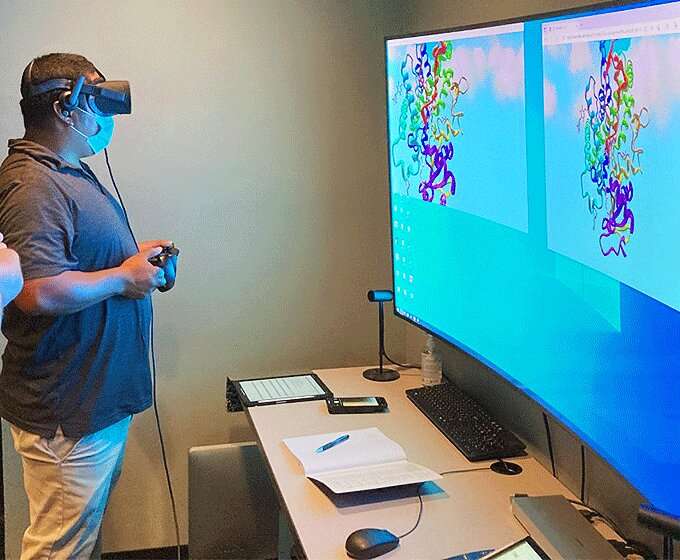Chemistry professor utilizes virtual reality to give students unique look at proteins

Francis Yoshimoto, assistant professor in the UTSA College of Sciences' Department of Chemistry, is introducing his Biochemistry II laboratory students to a new way of learning—using virtual reality headsets to observe and analyze protein structures.
Yoshimoto's students utilized the Department of Computer Science's VizLab to set up these virtual reality (VR) headsets. Students created snapshots of a protein using traditional computer software—such as Chimera or Pymol—and then went to the same region of the protein in ProteinVR, a web-based molecular visualization program that allows one to see proteins with a VR headset.
After comparing the two images, the students prepared 3D snapshots of other proteins and their interactions with ligands or protein partners by searching the protein databank for other human health-related proteins, such as the SARS CoV-2 spike protein, which the coronavirus uses to invade human cells.
The 3D VR headsets proved an effective way to instruct students about protein structures—immersing them in a unique learning experience. Under the ProteinVR viewer with the Oculus headset, students could change their viewing angles of the protein and navigate forward and backward using the joystick on the Oculus hand controller. With the headset on, students could travel inside the protein. If they wanted to move in a different direction around the protein, they could simply tilt their heads while wearing the headset and continue to move forward and backward with the joystick.
"For over 15 years, I have been looking at proteins just on my computer screen," Yoshimoto said. "Putting a virtual reality headset on to go inside an actual protein was truly an eye-opening experience for both myself and my students."
Virtual reality technology is already in use in the biomedical industry. It has, for example, been used to aid pharmaceutical businesses in their work designing novel drugs—a recent advancement for developing new medicines. By receiving exposure and training in VR technology, Yoshimoto's students were able to apply the skills they learn in the classroom in a way that is relevant to a future career in biomedical research. The project is representative of UTSA's commitment to programs that provide students with a greater understanding of marketable skills needed in the workplace and are particularly important in linking classroom success to life after graduation for historically underserved populations.
Yoshimoto and his lab instructors partnered with the university's Research Computing Support Group to arrange this VR learning experience.
Provided by University of Texas at San Antonio



















